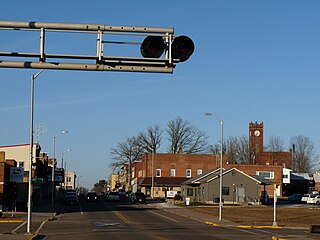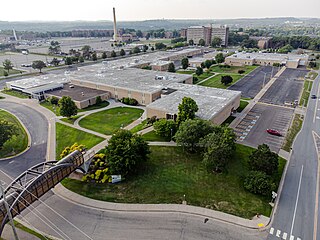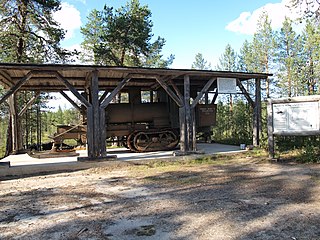
Chippewa County is a county located in the U.S. state of Wisconsin. It is named for the historic Chippewa people, also known as the Ojibwe, who long controlled this territory. As of the 2020 census, the population was 66,297. Its county seat is Chippewa Falls. The county was founded in 1845 from Crawford County, then in the Wisconsin Territory, and organized in 1853.

Chippewa Falls is a city located on the Chippewa River in Chippewa County in the northwestern part of the U.S. state of Wisconsin. The population was 14,778 in the 2021 census. Incorporated as a city in 1869, it is the county seat of Chippewa County.

Stanley is a city in Chippewa and Clark counties in the U.S. state of Wisconsin. The population was 3,608 at the 2010 census. Of this, 3,602 were in Chippewa County, and 6 in Clark County.

Eau Claire is a city in Eau Claire and Chippewa counties in the U.S. state of Wisconsin. It is the county seat of Eau Claire County. It had a population of 69,421 in 2020, making it the state's eighth-most populous city. It is the principal city of the Eau Claire metropolitan area, locally known as the Chippewa Valley, and is also part of the larger Eau Claire-Menomonie combined statistical area.

Rice Lake is a city in Barron County in northwest Wisconsin, United States, on the shore of the lake with the same name. The city is a commercial and tourist center for the surrounding rural areas. As of the 2020 census, the city had a total population of 9,040. The city is located mostly within the Town of Rice Lake.

Menomonie is a city in and the county seat of Dunn County in the western part of the U.S. state of Wisconsin. The city's population was 16,843 as of the 2020 census.

In the U.S. state of Wisconsin, the Central Plain is a geographical region consisting of about 13,000 square miles (34,000 km2) of land in a v-shaped belt across the center of the state. Beginning in the west, the Central Plain originates in Burnett and Polk Counties and runs southeast to Columbia County, where it turns northeast and reaches its end in Marinette County.

The Chippewa River in Wisconsin flows approximately 183 miles (294 km) through west-central and northwestern Wisconsin. It was once navigable for approximately 50 miles (80 km) of its length, from the Mississippi River, by Durand, northeast to Eau Claire. Its catchment defines a portion of the northern boundary of the Driftless Area. The river is easily accessible for bikers and pleasure seekers via the Chippewa River State Trail, which follows the river from Eau Claire to Durand.
Carson Park is a historic park located in Eau Claire, Wisconsin. It is located on a 134-acre (54.2 ha) peninsula created on an oxbow lake, Half Moon Lake, which was part of the former course of the Chippewa River. The park contains baseball, football, and softball venues, as well as the Chippewa Valley Museum.

Area codes 715 and 534 are telephone area codes in the North American Numbering Plan (NANP) for the U.S. state of Wisconsin. The numbering plan area (NPA) comprises most of the northern part of the state. 715 was one of the original North American area codes created in 1947, while 534 was added in 2010 as an additional code for the same numbering plan area to form an overlay plan.

Chippewa Valley Technical College is one of the 16 technical and community colleges in the Wisconsin Technical College System, centered in Eau Claire, Wisconsin. It serves an 11-county area, with its largest campus in Eau Claire and major regional centers in Chippewa Falls, Menomonie, Neillsville and River Falls.

The Eau Claire–Chippewa Falls metropolitan area refers loosely to the urbanized area along the Chippewa and Eau Claire Rivers, in west-central Wisconsin, with its primary center at Eau Claire and secondary centers at Chippewa Falls and Altoona.
Wisconsin's 3rd congressional district covers most of the Driftless Area in southwestern and western Wisconsin. The district includes the cities of Eau Claire, La Crosse, and Stevens Point, as well as many Wisconsin-based exurbs of the Minneapolis-St. Paul metropolitan area. It borders the states of Minnesota, Iowa, and Illinois. Republican Derrick Van Orden has represented the district since 2023.
The McCann brothers were three Irishmen who migrated from Ohio to Wisconsin in the mid-nineteenth century. They played an important role in the early phases of Wisconsin's lumber industry, and in the political and social organization of Chippewa County.

Chippewa River State Trail is a 26-mile urban-rural rail trail in western Wisconsin that follows the path of the Chippewa River. The trails runs from the spot of the confluence of the Chippewa with the Eau Claire River, at Phoenix Park in downtown Eau Claire, meeting up with the Red Cedar State Trail near Red Cedar, to Durand. A former railroad corridor, the trail passes through a variety of habitat including wetlands, prairies and sandstone bluff.
Knapp, Stout & Co. was a lumber company based in Menomonie, Wisconsin in the 19th and early 20th centuries. The company was established in 1846, when John Holly Knapp and William Wilson purchased half of interest in a lumber mill on the Red Cedar River from David Black; it was originally known as Black & Knapp. Later Andrew Tainter acquired a quarter-interest, and the company has become Knapp-Tainter Lumber Company. Henry Stout bought a quarter interest in the company in 1853, and its name became Knapp, Stout & Company. The company's location allowed it to control the lumber industry in the region, and by 1870 it controlled the logging industry in the Red Cedar River valley. In 1878, the company incorporated, and its official name became the Knapp, Stout & Co., Company. The company employed over 2,000 workers in the Menomonie area and produced 85 million board feet of lumber on average yearly from 1871 to 1896; its output made it the largest lumber company in the world. In the 1880s, the company expanded to sites along the Mississippi River, opening offices in Dubuque, Iowa, Read's Landing, Minnesota, and St. Louis. By the 1900s, the company had largely depleted its lumber supply; it closed many of its camps and dissolved early in the 20th century. The company sent out its last shipment of lumber on August 12, 1901.
WESTconsin Credit Union is a not-for-profit financial cooperative that was founded as Menomonie Farmer's Credit Union in 1939. WESTconsin is headquartered in Menomonie, Wisconsin. Currently, they have over 100,000 members and control more than $1.1 billion in assets, with offices in the Wisconsin communities of Altoona, Amery, Baldwin, Barron, Chippewa Falls, Eau Claire, Ellsworth, Hudson, Menomonie, New Richmond, Prescott, River Falls, and Spring Valley. WESTconsin Credit Union has also gained notice for their high school offices, located in Amery, Baldwin-Woodville, Menomonie, and New Richmond.

The Phoenix Manufacturing Company, later the Phoenix Steel Company, was one of Eau Claire, Wisconsin's oldest manufacturing firms. It manufactured equipment predominantly for the sawmill and logging equipment industries, which were vital to the establishment and growth of Eau Claire.
Adin Randall was a philanthropist, businessman, and politician in the Chippewa Valley of Wisconsin, who served as a first Treasurer of Eau Claire County, Wisconsin. He ran a ferry across the Chippewa, a planing mill, a sash and door factory, and invented the sheer boom to efficiently shunt logs into Half Moon Lake. He is regarded as one of the founders of the city. He donated the land for Randall Park, Lakeview Cemetery and the Eau Claire Area School District.

Orrin Henry Ingram was an American lumber baron and philanthropist from Eau Claire, Wisconsin. Orphaned at age 11, he established sawmills in Ontario, Canada, and the Chippewa Valley of Wisconsin. He was a banker and philanthropist in Eau Claire.















